2025.04.15
The Art of Kaiseki: Discover Tokyo’s Premium Dining with Artisanal Gluten-Free Soy & Miso
By Chef Yuuki Tanaka, owner of Ise Sueyoshi — Tripadvisor Best of the Best: Japan #1, World #12.(source).
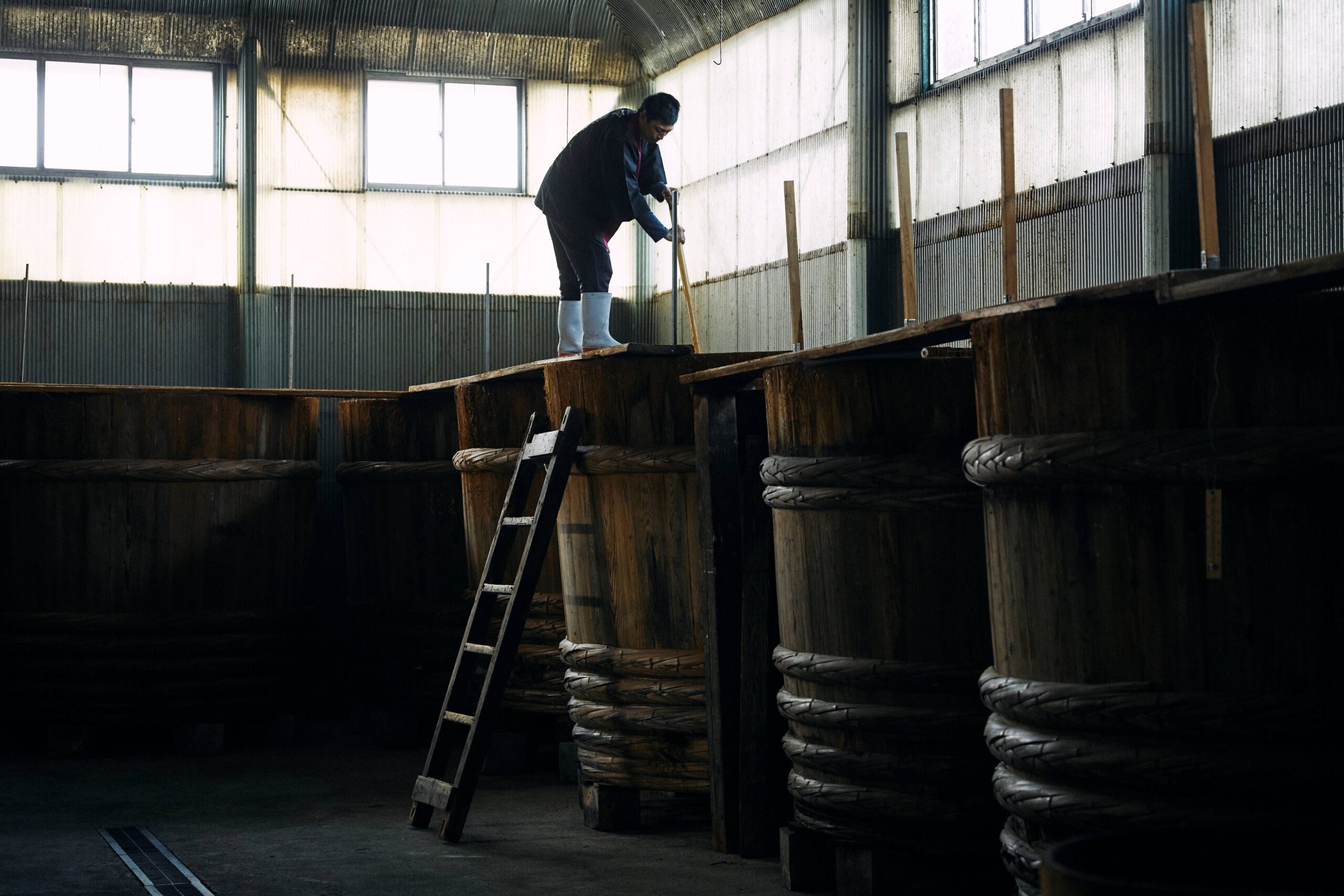
What You’ll Learn in This Article
• What soy sauce (shoyu) and miso are, and their significance in Japanese cuisine
• How traditional Japanese seasonings are made and their typical ingredients
• Why these seasonings often contain gluten—and what to watch out for
• What gluten-free soy sauce options are available in Japan
• How Ise Sueyoshi accommodates gluten-free guests in a kaiseki experience
Essential Japanese Seasonings
When exploring the heart of Japanese cuisine—commonly known as washoku—one quickly discovers that its delicate and profound flavors are built upon surprisingly simple, yet incredibly versatile, seasonings. At the very core of these seasonings lie two indispensable pillars of Japanese culinary tradition: shoyu (soy sauce) and miso.
Though both are well-known across the globe, the complex flavor profiles of these seasonings—and the countless regional and artisanal variations born from differences in climate, ingredients, and technique—are far more intricate than most realize. In the refined world of kaiseki cuisine, which emphasizes seasonality and the subtle elevation of natural ingredients, soy sauce and miso serve not just to season, but to define the very essence of a dish. A single variation in the type of shoyu or miso used can transform the entire dining experience.
In this article, we delve into the secrets behind Japan’s most iconic seasonings and explore how they shape the soul of Japanese cuisine. We hope this journey deepens your appreciation of Japanese food and enriches your next culinary adventure.
Flavor’s Soul: Shoyu
Shoyu (soy sauce) is nothing less than the soul of Japanese cuisine. While it may appear simple at first glance, it is in fact a profound expression of the art of fermentation. Born from the delicate interplay of soybeans, wheat, salt, and koji mold, this dark, savory liquid transcends its role as a seasoning. It delivers umami—Japan’s celebrated “fifth taste”—bringing a rich depth and harmony to dishes that amplifies the natural flavors of each ingredient.
Traditional brewing methods, particularly long-term fermentation in wooden barrels, are refined and intricate, much like a symphony. Craftsmen preserve and reuse the same barrels over generations, allowing the unique ecosystem of microorganisms within to impart a distinct, evolving character to each batch. This results in a complexity and richness of flavor that mass-produced soy sauces simply cannot replicate.
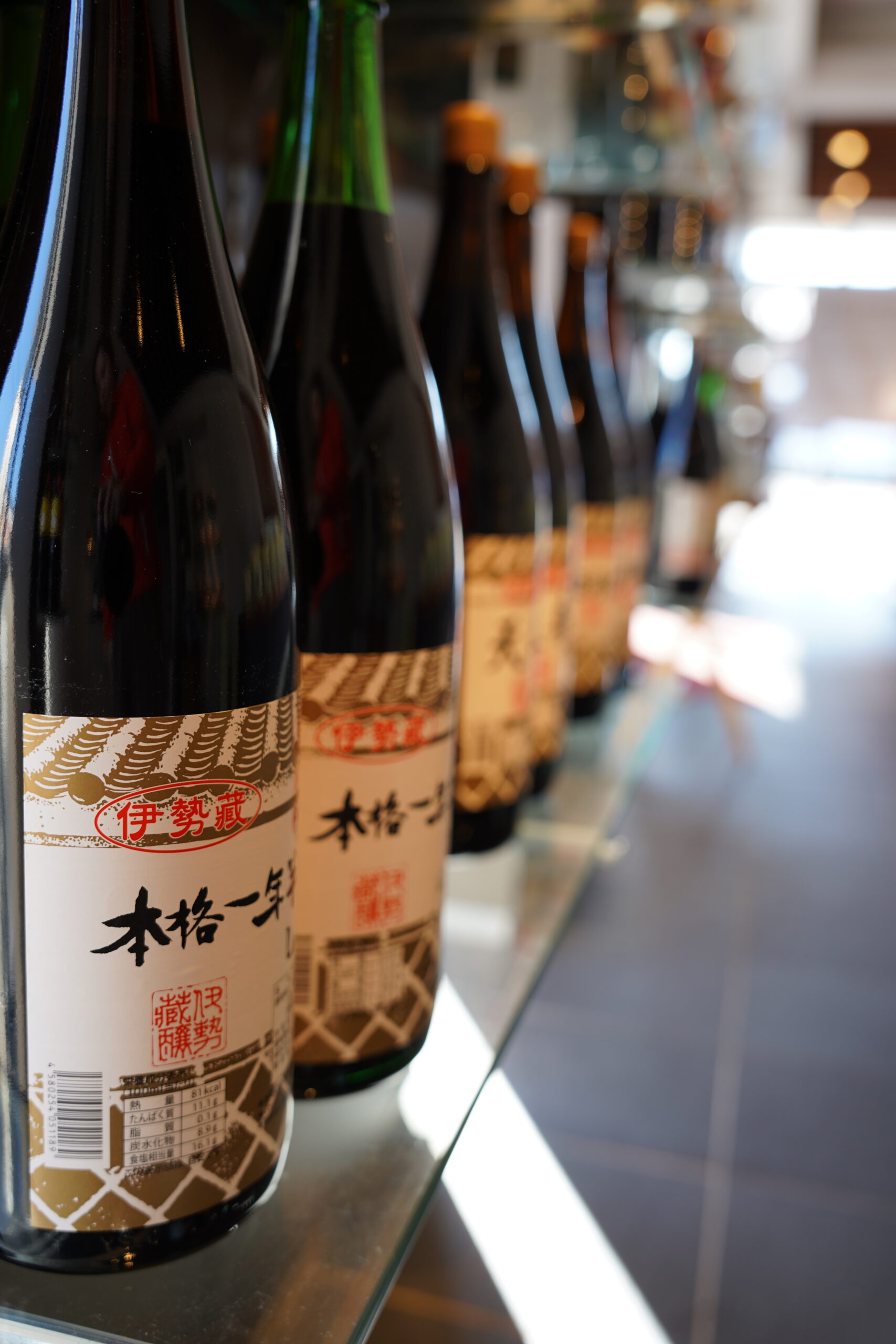
The world of shoyu is remarkably diverse. From koikuchi (dark soy sauce) and usukuchi (light soy sauce) to tamari and saishikomi (double-brewed), each type complements different dishes and ingredients. For chefs, choosing the right soy sauce is akin to selecting a palette of colors—an act of artistic precision. While commercial shoyu aims for uniformity, artisanal varieties embrace seasonality and the nuances of each ingredient, resulting in a sauce that evolves with nature.
A single drop of shoyu contains a rich narrative—one that reflects the essence of Japanese culinary tradition. It is a small, yet profoundly powerful symbol of flavor, craftsmanship, and cultural depth.
The Craft of Miso
Alongside shoyu, miso is another essential fermented seasoning that enriches the Japanese dining experience. Humble in its appearance yet profoundly diverse in its forms and techniques, miso reflects the deep cultural and culinary heritage of Japan. Its foundational ingredients are simple—soybeans, salt, and koji, the fermentation starter—but the type of koji used (such as rice koji or barley koji) and its ratio significantly shape the flavor and character of the final miso.
The heart of miso-making lies in the slow, natural process of fermentation and aging. Over time, microorganisms break down the proteins and carbohydrates in the soybeans, releasing amino acids, sugars, and aromatic compounds. This transformation yields a complex and layered taste—not just salty, but sweet, savory (umami), and occasionally with hints of acidity or bitterness. It is a kind of alchemy where nature and time work together to create flavor dimensions beyond words.
Miso spans a broad spectrum of colors and flavors. For example, white miso—fermented for a shorter period and with a higher proportion of rice koji—offers a light, sweet flavor and silky texture, perfect for delicate dishes. In contrast, red miso—aged longer and made with more soybeans—develops a bold, deep umami, with hints of astringency, making it ideal for heartier preparations. There is also awase miso, a blended miso, showcasing the diversity of regional and household preferences across Japan. This abundance of variation is a testament to the richness of Japanese culinary culture.
Each region of Japan boasts its own unique jimoto miso (local miso), shaped by local climates, traditions, and techniques. These artisanal miso varieties, crafted by skilled hands using time-honored methods, stand apart from mass-produced versions in both flavor and aroma. They carry the spirit of the land and the knowledge of generations.
While miso soup is its most well-known application, miso’s culinary potential is far broader. It is used to dress vegetables, marinate meats and fish for grilling, and add depth to stews and braises. Beyond its versatility, miso also offers health benefits—it is a natural probiotic, supporting gut health and digestion. In this way, miso is more than a seasoning. It is a living expression of Japan’s nature, time, and craftsmanship—a true edible work of art.

Gluten-Free Soy
For those eagerly anticipating an authentic Japanese culinary experience—especially the delicate flavors of kaiseki cuisine—gluten-related concerns may pose a significant challenge. As mentioned earlier, soy sauce, one of Japan’s most iconic seasonings, traditionally contains wheat as a key ingredient. This makes most commercially available soy sauces unsuitable for gluten-free diets.
However, there is good news. Even those avoiding gluten can still enjoy the rich, nuanced flavors that define Japanese cuisine.
One traditional option is tamari soy sauce, which is made primarily from soybeans and often contains little or no wheat. Tamari is known for its deep umami flavor and thicker consistency. However, it’s important to note that not all tamari is completely gluten-free—some may still contain trace amounts of wheat or be processed in facilities where cross-contamination can occur. For individuals with celiac disease or strict gluten intolerance, it’s essential to check labels for certified gluten-free marks and ingredient lists to ensure safety.
In response to growing demand, many artisanal producers now offer specially brewed gluten-free soy sauces. These versions use gluten-free grains such as rice instead of wheat, and are crafted under rigorous controls to avoid cross-contamination. Many also carry third-party gluten-free certifications, offering peace of mind and authentic flavor.
What about miso? Fortunately, many types of miso are naturally gluten-free. Rice miso (kome miso) made with rice koji, or soybean-based miso using bean koji, typically contain no gluten. However, varieties such as barley miso (mugi miso) use barley and are therefore not safe for those on a gluten-free diet. As with soy sauce, it’s important to verify each product or restaurant’s ingredients.
Above all, quality matters. For a refined cuisine like kaiseki—where the subtle interplay of ingredients and seasonings is crucial—choosing high-quality, authentically crafted gluten-free soy sauce and miso is essential. When created by skilled artisans using traditional methods, these condiments offer no compromise in flavor or integrity. They uphold the richness of Japanese culinary heritage while welcoming all to the table.
For more about our vegan and gluten-free philosophy, please visit this page.
Isegura’s Artisan Craft
Behind the delicate and profound flavors of the kaiseki cuisine served at Ise Sueyoshi lies a quiet but powerful presence: the soy sauce and miso crafted by Isegura, a century-old artisanal brewery based in Mie Prefecture. More than just a supplier, Isegura is a treasured partner in our shared pursuit of authentic Japanese culinary excellence—a bond forged through generations of mutual trust and respect.
At the heart of Isegura’s philosophy is a steadfast commitment to traditional methods, undisturbed by the currents of modern efficiency. Most notably, their use of kioke-jikomi—wooden barrel fermentation—is a living tradition where time, not technology, brings out the essence of flavor. Within these wooden barrels reside generations of beneficial microorganisms, quietly transforming simple ingredients into soy sauce and miso that carry a depth, complexity, and vitality that mass-produced products simply cannot replicate. This is fermentation as art—an expression of Mie’s natural terroir, the wisdom of master brewers, and their unwavering passion for true craftsmanship.
Why does Ise Sueyoshi choose Isegura above all others? It is not only for the extraordinary taste, but for the values we share. Their uncompromising dedication to quality, their resolve to carry tradition into the future, and their profound respect for the ingredients—all of these resonate deeply with our culinary philosophy. Chef Yuuki Tanaka himself visits the brewery to speak directly with the artisans, strengthening a relationship that forms the very foundation of our cuisine.
The soy sauce and miso delivered from Isegura are not mere seasonings—they are the soul of our dishes. They infuse each course with a story from Ise, grounding our food in authenticity and spirit. For us, they symbolize our unwavering commitment to quality and our desire to offer guests not just a meal, but a truly unforgettable culinary experience.
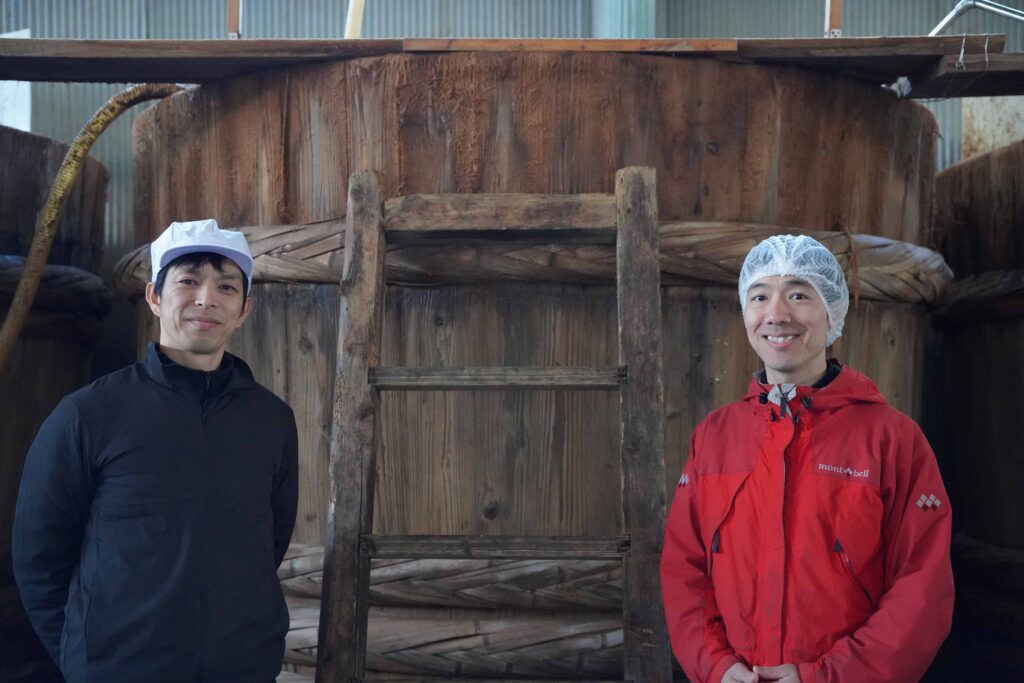
What is Kaiseki?
Kaiseki cuisine is widely regarded as the pinnacle of Japanese culinary culture. Yet it is not simply about using luxurious ingredients or showcasing extravagant dishes. Rather, Kaiseki is a meticulously orchestrated multi-course meal, served one dish at a time in a specific sequence—a distinct contrast to à la carte dining or sushi-centered meals.
At the heart of Kaiseki lies a deep-rooted philosophy. The most vital element is seasonality. Kaiseki chefs honor the natural rhythm of the year by showcasing ingredients at their peak—celebrating the hashiri (early season), sakari (in full bloom), and nagori (lingering end) of each seasonal bounty. Next is harmony—a balance not only of flavors but also textures, colors, and the interplay between food and tableware. No detail is overlooked. Lastly, there is the art of presentation. In Kaiseki, every dish is a visual expression, a carefully arranged composition that delights the eye before it ever touches the palate.
Kaiseki’s roots can be traced back to the refined hospitality of the Japanese tea ceremony. Its essence embodies the spirit of ichigo ichie—a once-in-a-lifetime moment shared with others. This is not merely a meal, but a culinary journey, thoughtfully designed by the chef to express nature, aesthetics, and heartfelt hospitality.
Beginning with a light appetizer (sakizuke), followed by a clear soup (wanmono), sashimi (otsukuri), grilled dish (yakimono), rice and pickles (shokuji), and concluding with a delicate dessert (mizumono), the Kaiseki experience unfolds like a narrative, each course a chapter in a seasonal story.
To experience Kaiseki is to witness Japan’s unique cultural and artistic expression—one that engages all five senses and transcends the act of eating. It is a moment of discovery, emotion, and beauty—an unforgettable encounter with the soul of Japanese cuisine.
Read more: What is Kaiseki cuisine?

Seasonal Ingredients & Umami
At the heart of every Kaiseki course lies a single, profound concept: “Shun”—the peak moment of a seasonal ingredient’s flavor and vitality. It is the fleeting, perfect window when nature offers its finest. Kaiseki chefs align themselves with this rhythm, capturing that one ephemeral moment in taste. Think of spring’s tender bamboo shoots, fragrant and crisp. The melting sweetness of eggplant ripened under the summer sun. The earthy richness of autumn mushrooms, and the intense sweetness of winter Ise lobster, its flavor deepened by the cold sea. These encounters with seasonally perfect ingredients—transient, vivid, and irreplaceable—leave a lasting impression on all who experience them.
Yet alongside these momentary treasures, Japanese cuisine also relies on a set of timeless, umami-rich staples. Often called the “fifth taste” alongside sweet, salty, sour, and bitter, umami gives Japanese cuisine its soul. Delicately extracted broths (dashi) from kombu (kelp) or katsuobushi (dried bonito) provide the structural base for many dishes, regardless of season. Fermented seasonings like soy sauce and miso—especially those made through time-honored methods like those at Isegura—bring layers of complex, matured umami, the result of patient fermentation and the wisdom of generations.
The true mastery of Kaiseki lies in orchestrating the harmony between these two elements: the fragile, vibrant beauty of seasonal ingredients, and the enduring, cultivated depth of umami-rich elements. The aim is not simply to combine flavors, but to elevate each one—so that the stock, sauces, and seasonings provide a canvas on which the seasonal ingredients can fully express their subtle nuances. This interplay—of impermanence and permanence, of freshness and maturity—creates a layered depth of flavor that defines Kaiseki. It’s this fusion of season and structure, fleeting aroma and timeless taste, that captivates gourmets around the world and makes Kaiseki a uniquely refined culinary experience.
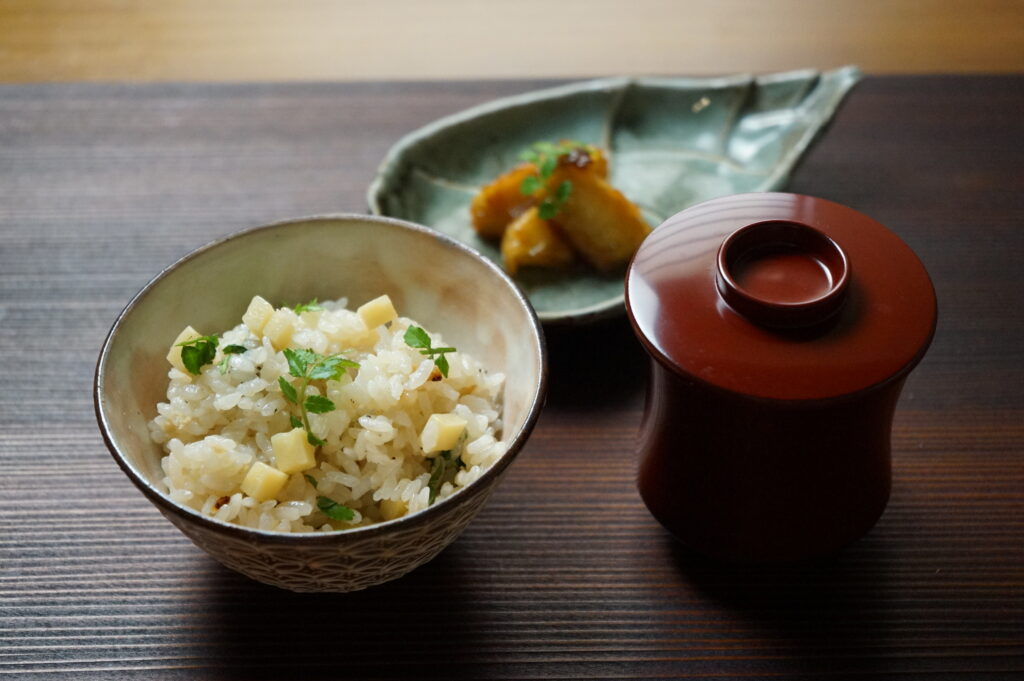
Kaiseki with Soy & Miso
In the refined world of Kaiseki cuisine, soy sauce and miso are far more than mere seasonings. Unlike in casual home cooking, where they might be used indiscriminately to add saltiness or flavor, in Kaiseki, they are applied with precision and purpose—subtly enhancing a dish without ever overpowering it. They are not the star of the plate, but rather, the quiet force that elevates, balances, and completes each component, often playing the role of the final touch that brings the entire composition to life.
At Ise Sueyoshi, we take this philosophy a step further. Working closely with our long-time partner, the century-old brewery Isegura, we start with their exceptional artisanal soy sauces and miso, but then refine and differentiate further through our own exacting approach. One such example is our use of five distinct types of soy sauce, each selected for its unique qualities and intended purpose.
Why so many? Because in Kaiseki, the role of soy sauce must adapt to the dish, the ingredients, and the moment. For instance, for sashimi (otsukuri), where the clean sweetness of fresh seafood must shine, we craft a custom soy blend using rich tamari—dark, concentrated, and gluten-light—to avoid clouding the color or masking the flavor. In contrast, a light vegetable dish like ohitashi calls for a gentler, more aromatic usukuchi (light soy sauce), which lifts the natural character of the greens. For dishes requiring a glossy finish, we turn to koikuchi (dark soy sauce) for its depth and sheen.
This artful selection of soy sauces is more than technical skill—it reflects the chef’s deep understanding of ingredients, sharpened over years of experience and honed by an acute palate and aesthetic sensibility. It is a form of culinary expression, where each drop of seasoning is chosen as carefully as a painter chooses a pigment.
In Kaiseki, soy sauce and miso are indispensable supporting actors—they never steal the scene, yet their presence defines the harmony of the meal. Through this quiet mastery, each dish becomes more than a sum of its parts—it becomes a deeply nuanced experience, full of subtle discovery and unforgettable flavor.
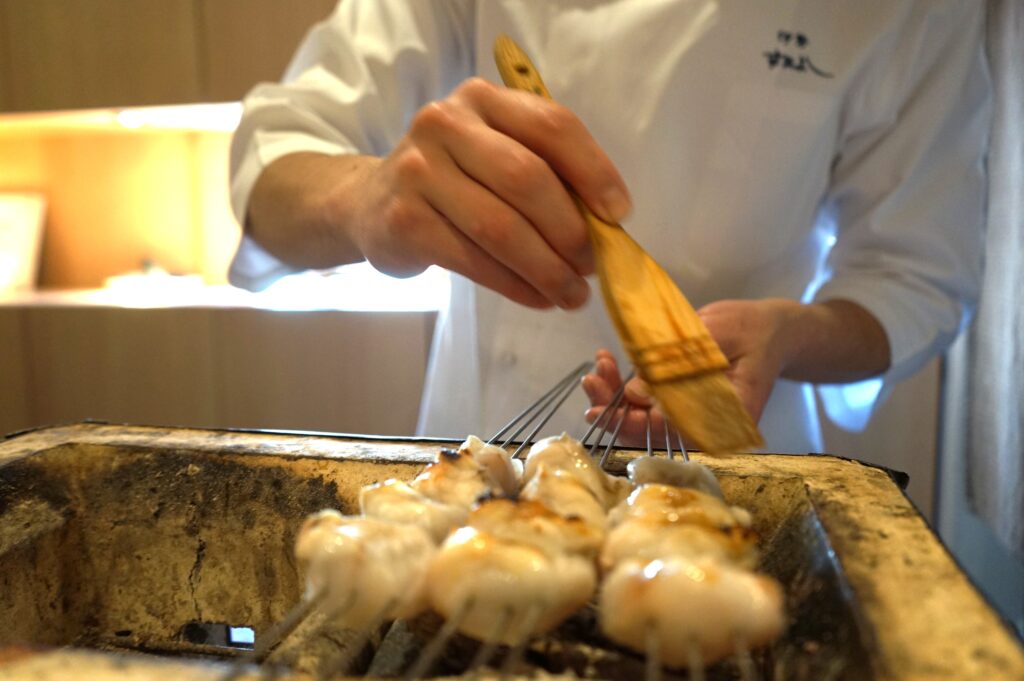
Inclusive Gourmet Dining
At Ise Sueyoshi, we believe that the joy of food should know no boundaries. Dietary restrictions—whether gluten-free, vegetarian, or vegan—should never exclude anyone from experiencing the pinnacle of Japanese cuisine. Our commitment is to provide an uncompromised Kaiseki experience that respects both tradition and the diverse needs of our guests.
We proudly use gluten-free soy sauce and miso crafted by the artisans of Isegura, ensuring that guests with gluten sensitivities can enjoy the same delicate depth and nuance as those without restrictions. These seasonings are not substitutes—they are authentic, carefully brewed condiments that preserve the integrity of our cuisine.
For guests who follow vegetarian or vegan diets, we offer specially designed Kaiseki courses by advance reservation. These menus honor the spirit of Kaiseki, using only the finest seasonal vegetables, thoughtfully selected ingredients, and traditional cooking techniques to create dishes of remarkable beauty and flavor.
We view dietary accommodations not as limitations, but as an opportunity to express greater creativity and hospitality. Every plate carries the same craftsmanship, respect for ingredients, and seasonal storytelling that define our approach. Our mission is to open the doors of Japanese fine dining to everyone—no matter their dietary needs.
In the diversity of our guests, we find the true brilliance of Japanese food culture. At Ise Sueyoshi, we strive to create an inclusive culinary space where all guests can explore and savor the profound beauty of authentic Japanese cuisine—with peace of mind, and with full hearts. Our dishes are not just meals—they are bridges of flavor, connecting people across cultures through the universal language of food.
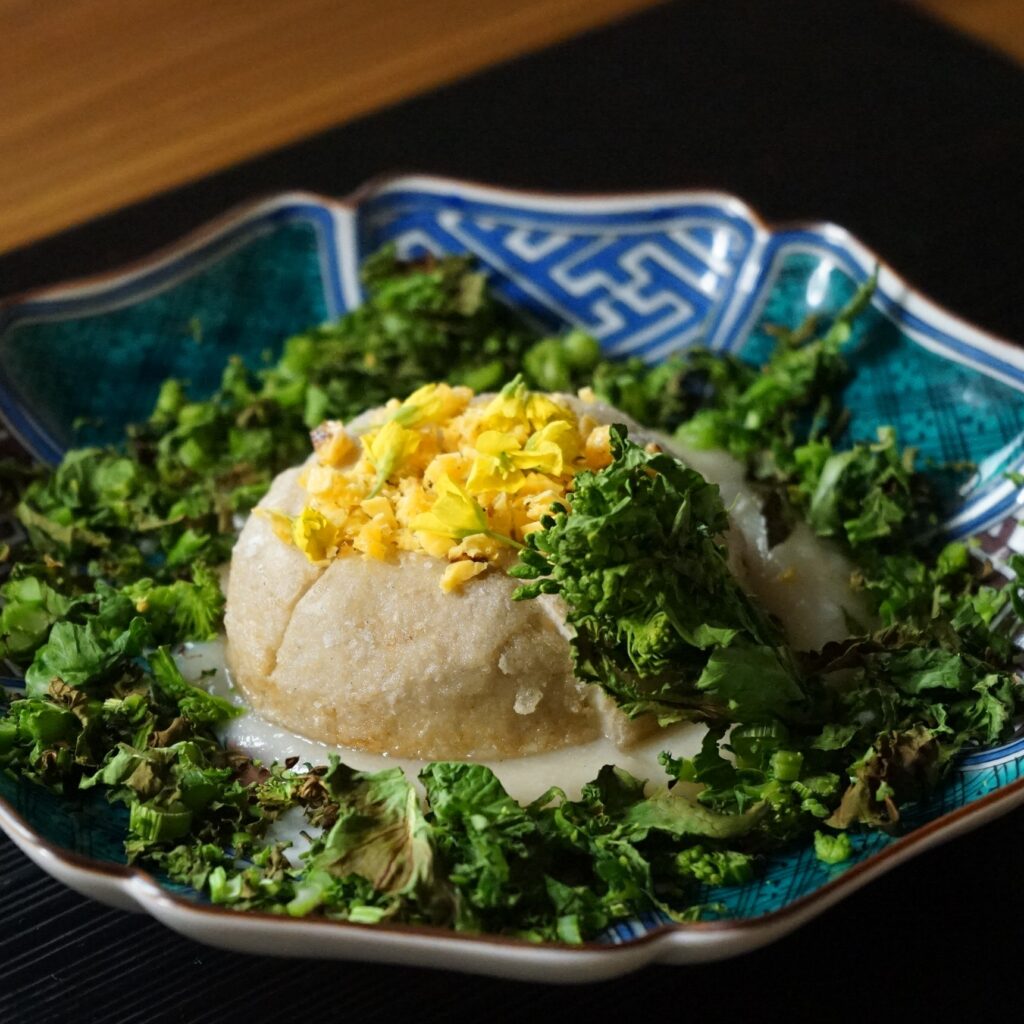
For more about our vegan and gluten-free philosophy, please visit this page.
Chef’s Heartfelt Passion
At Ise Sueyoshi, each delicate and deeply considered Kaiseki dish is infused with the spirit of our head chef, Yuuki Tanaka. His approach to cooking goes far beyond technique—it is rooted in a profound passion to honor the finest ingredients nurtured by Japan’s natural bounty, to preserve the culinary heritage passed down by generations, and to share these treasures with guests from all over the world. Many of the ingredients used at Ise Sueyoshi are personally sourced from his beloved home region, Mie Prefecture.
At the core of Chef Tanaka’s philosophy is one word: connection. He visits every producer himself—learning not only about the land and the craftsmanship behind each ingredient, but also the stories, values, and personal dedication of those who create them. His relationship with producers like Isegura, whose mission aligns closely with his own, reflects a mutual trust and shared respect. He strives to carry their spirit into the dishes he prepares, bridging field and table with authenticity and heart.
While he holds the traditional methods of Japanese cuisine in the highest regard, he also embraces a modern sensibility—seamlessly blending the wisdom of the past with innovation and refinement. This harmony is what makes the Kaiseki experience at Ise Sueyoshi truly one of a kind.
For international guests, Chef Tanaka has a special desire: to help them experience the essence of Japanese food culture, beyond language or custom. He hopes each guest not only finds the cuisine delicious, but also walks away with new insight, a sense of comfort, and a deepened curiosity. To that end, both he and his team take care to explain each dish in English whenever possible, ensuring the story of the meal is fully appreciated.
From his love for the blessings of Mie, to his reverence for the hands that produce each ingredient, and his sincere hospitality for every guest—Chef Yuuki Tanaka’s unwavering passion transforms each meal at Ise Sueyoshi into more than a dinner. It becomes an unforgettable story, lovingly told through food.

Read More about Chef Yuuki
The Story of Tokyo’s Best Chef, Yuuki Tanaka: Bringing the Blessings of His Hometown to the World
Hospitality at Ise Sueyoshi
One of Japan’s most admired cultural values is omotenashi—a spirit of selfless hospitality that goes far beyond polite service. At its heart, omotenashi is the sincere desire to anticipate unspoken needs and respond with genuine warmth and mindfulness. At Ise Sueyoshi, this philosophy is reflected in every detail—from the ambience of the space to the nuances of guest interaction.
Our dining area centers around an intimate counter-style setting, carefully designed to eliminate any barriers between the chef and guests. This arrangement invites you to engage in a shared experience of culinary artistry—watching dishes come to life, feeling the rhythm of preparation, and enjoying natural conversation with the chef. While the setting is refined, it retains a sense of warmth and ease—welcoming guests not just to dine, but to become part of the story behind the meal.
Within this welcoming space, hospitality becomes an essential part of how each dish is appreciated. As every course is served, the team carefully explains the seasonal ingredients, the intention behind the preparation, and how traditional elements like Isegura’s artisanal soy sauce and miso are skillfully incorporated. These moments are more than simple explanations—they are an invitation to explore, learn, and engage with the flavors on a deeper level, enriching the experience with context and meaning.
It is the passion of the chef, the exceptional quality of the ingredients, and the heartfelt spirit of omotenashi that together shape a dining experience that resonates across all five senses. From the moment you step through the door until the final farewell, our entire team is devoted to ensuring that you feel genuinely welcomed, cared for, and deeply satisfied. At Ise Sueyoshi, dining is not just about the meal—it is a moment of connection, comfort, and cultural immersion that stays with you long after the last bite.
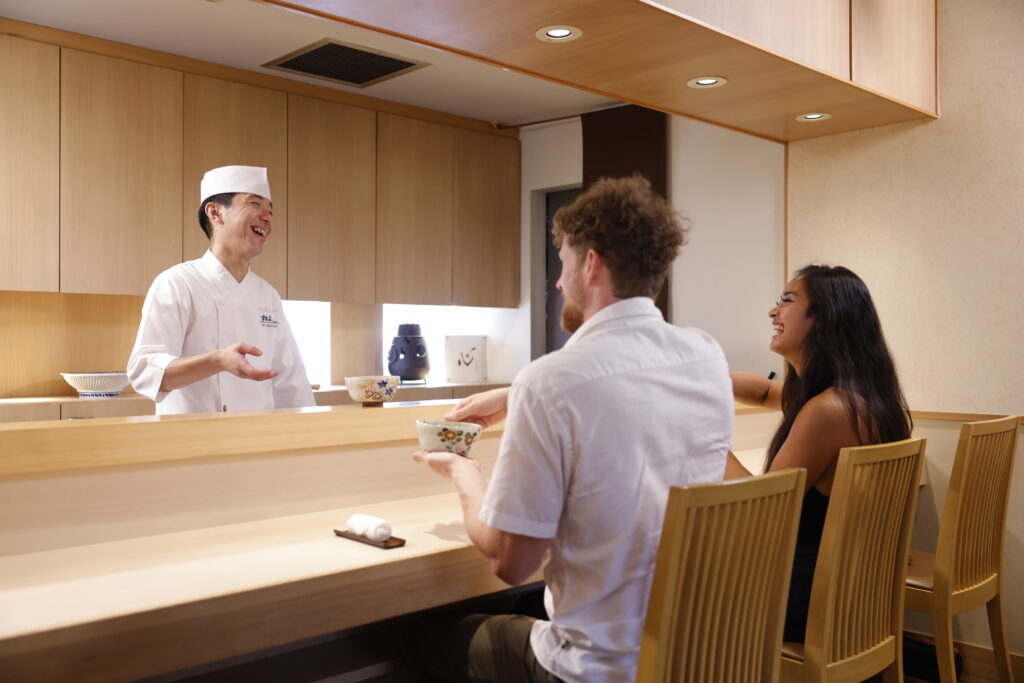
Ise Sueyoshi’s Dishes
At Ise Sueyoshi, we serve a kaiseki experience that reflects the fleeting beauty of Japan’s natural seasons—a true expression of “ichigo ichie”, the belief in treasuring each unique encounter. Every ingredient is carefully selected from across Japan, with a particular focus on Mie Prefecture, the chef’s hometown, to capture the finest seasonal flavors that can only be experienced in the present moment.
In winter, for example, guests may enjoy exquisite dishes featuring delicacies such as wild-caught torafugu (tiger pufferfish) with its rich umami and firm texture, Ise ebi (Japanese spiny lobster)—celebrated for its sweet and refined meat, perfect for special occasions, or premium wagyu beef with fine marbling that melts delicately on the tongue. These are just a few examples, showcasing our unwavering commitment to the highest quality ingredients.
Each dish is prepared with expert precision and deep respect for the natural character of the ingredients. Fresh seafood is transformed into sashimi, allowing its pure flavors to shine. Ingredients that benefit from aroma and texture are grilled slowly over binchotan charcoal, while those best expressed through depth and warmth are carefully simmered in fragrant seasonal dashi to draw out their essence. Raised in the pristine waters of Shima, Mie Prefecture, Ise Maguro offers a perfect balance of rich umami in its red flesh and delicate marbling, making it an exceptional highlight of any course.
What we value above all else is shun, the philosophy of seasonality at the heart of kaiseki cuisine. For this reason, Ise Sueyoshi does not offer a fixed menu. Instead, our courses change regularly—sometimes even daily—based on what is at its peak in the markets and nature. Each visit brings new discoveries, new expressions of the season, and new emotional connections to the food.
This ever-changing experience is what makes dining at Ise Sueyoshi truly authentic—a culinary journey where every course is a reflection of time, place, and heartfelt craftsmanship.

Read More about Wagyubeef
Read More about fugu (pufferfish)
Read More about Ise Ebi Lobster
Read More about Tuna
Unforgettable Tokyo Memories
Dining at Ise Sueyoshi is far more than just a meal—it’s an unforgettable story that captures the very essence of your journey through Tokyo. It is a space where Japan’s culinary culture is expressed in its purest and most refined form. In every moment, the passion of Chef Yuuki Tanaka, the finest seasonal ingredients from Mie Prefecture, the timeless techniques of traditional kaiseki cuisine, and warm, attentive hospitality come together in perfect harmony.
From the careful selection of ingredients to the precise cooking methods and the final dish served, Ise Sueyoshi embodies a relentless respect and curiosity for Japanese food culture. The experience is inclusive, welcoming guests with dietary restrictions such as gluten-free, vegetarian, or vegan, without ever compromising the essence of kaiseki. Here, tradition and innovation, authentic flavor and modern sensibility are seamlessly woven together.
To elevate the experience even further, a curated sake pairing accompanies the meal. Selected from renowned breweries in Mie, each sake is served in a unique vessel and carefully matched to the flavors and textures of each course. This pairing is not simply a beverage accompaniment—it is a refined, sensory journey that deepens your appreciation of each dish and enhances the overall dining experience.
With every visit, you’ll uncover something new—like a living museum of Japanese culinary culture. Each plate speaks to the beauty of nature, the mastery of artisanship, and the depth of tradition. This is not just a meal, but a full sensory and cultural immersion.
For those seeking a memory of Tokyo that is not only delicious but deeply moving, Ise Sueyoshi promises to become the most treasured jewel of your journey.
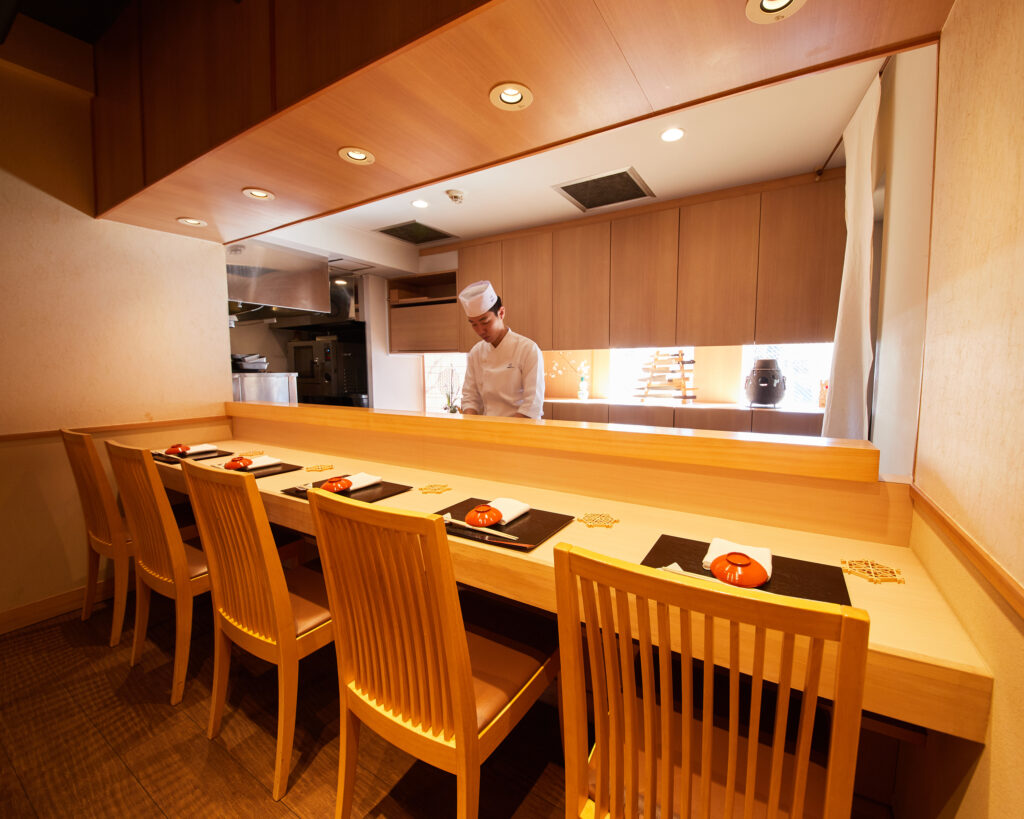
Read more about Sake Pairing:
Enhance Your Kaiseki Experience in Tokyo: Sake Pairing for Ultimate Satisfaction
Feb 2025 • family
An incredible experience from start to finish! The restaurant is located a few floors up in a building. When you walk in the restaurant is very small with a counter with 4 seats and a private room. We were a party of 4 and sat at the counter and were the only ones in the restaurant. We got to watch Chef Yuuki and his sous chef create an incredible meal in front of us. Someone in our party ordered the sake pairing as well and received a sake pairing for each dish! I have to eat gluten free. When booking, I made a note on the reservation and there is a ¥2,000 fee for gluten free. Yuuki was able to accommodate me just fine! The whole dinner was meticulously curated and so delicious!! This is worth every penny to have this Japanese Kaiseki experience!
We are proud to continue delivering an exceptional dining experience that earned us the Tripadvisor Travelers’ Choice Best of the Best 2024 award, ranking among the Best Restaurants in Tokyo. Our commitment to excellence in service and our dedication to offering the finest kaiseki dining experience in Tokyo remain unwavering. Discover more about our journey to becoming one of the best restaurants in the city[here].

Visit Ise Sueyoshi
Location: Conveniently located 12 minutes from Roppongi Station and 8 minutes from Hiroo Station.
Hours: Open 5:00 PM – 10:00 PM, reservations only. Closed on Sundays and Mondays.
Book Your Experience ☟
Conclusion
At Ise Sueyoshi, we humbly invite you to experience a dining journey that caters to all dietary needs. Whether you’re vegan, halal, or have specific preferences, we are here to create a memorable and inclusive dining experience for you, especially for special occasions like a honeymoon.
Recommended Blog Posts
On our blog, we offer further insights into Tokyo’s rich food culture and the unique culinary experiences we provide at Ise Sueyoshi. Be sure to check out these recommended posts:
@isesueyoshi
o 🏆 Awarded the prestigious Best Luxury Restaurant by TripAdvisor
o 🌍 Ranked 2nd worldwide, 1st in Japan, and 1st in Asia
o ⭐ Google rating of 4.9 (as of 2024)
o ✅ Vegan-friendly
o ✅ Halal selections
o ✅ Gluten-free options
o ✅ Vegetarian delights
o ✅ Pork-free choices
o ✅ Perfect for pescatarians
o 🌈 Welcoming and inclusive environment for LGBTQ guests
o 🚃 Just a 12-minute walk from Roppongi Station or 8-minutes from Hiroo Station
o ⏰ 5:00 PM – 10:00 PM (reservations-only)
o 📅 Closed on Sun and Mon
